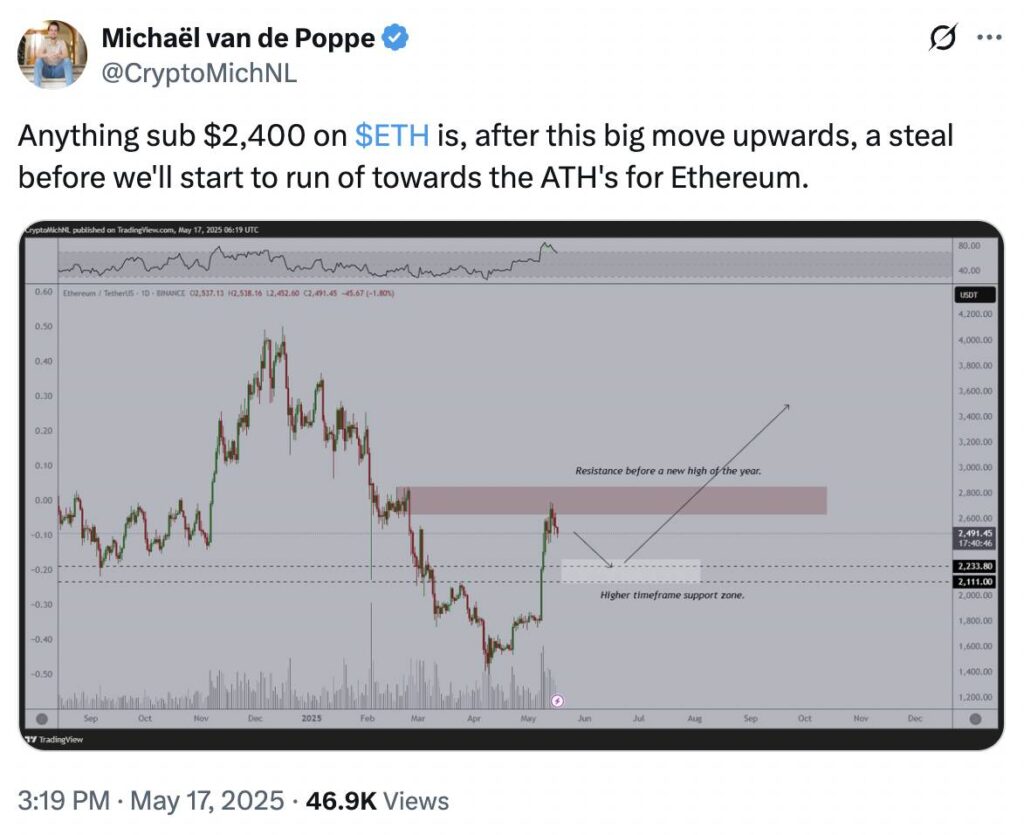On May 19, the cryptocurrency landscape was painted in red as Ether (ETH), the second-largest digital currency, witnessed a notable decline, falling over 5% to around $2,380. This downturn was part of a broader trend affecting the entire market, where total cryptocurrency capitalization dipped by approximately 1.40%, reflecting investors’ cautious sentiment amid rising economic uncertainties.
In the last 24 hours, Ether’s price plummeted from a high of $2,587 on May 18, dipping to an intraday low of $2,353. Such volatility was accompanied by a surge in trading volume, which soared by 110% to $30.4 billion, highlighting the intensified market activity as traders reacted to the price swings. Other significant digital currencies, including Bitcoin and popular altcoins like XRP and Solana, also experienced losses during this timeframe.
“Long liquidations accelerated Ether’s downtrend,” noted market analysts, as over $255 million worth of ETH positions were wiped out within a single day, primarily driven by traders being forced to exit their leveraged bets amid the price drop.
The crypto market’s challenges were exacerbated by recent financial news, including Moody’s Ratings downgrading the U.S. credit score for the first time since 1919. This downgrade, attributed to the nation’s skyrocketing debt and fiscal deficits, has set off ripples across financial markets, resulting in higher Treasury yields and increased borrowing costs. Consequently, investors have been gravitating away from riskier assets like cryptocurrencies.
As ETH struggles to maintain crucial support levels, market watchers are keen to see if it can stabilize above $2,400. The bear market momentum is evident, with analysts observing that Ether’s relative strength index (RSI) has significantly declined, suggesting a growing bearish outlook as profit-taking continues.
The ongoing volatility invites attention from traders and investors alike, with some identifying potential buy-the-dip opportunities amidst the market turmoil. However, the air of uncertainty remains thick, urging participants to navigate this turbulent landscape with caution.
Key Takeaways from Recent Ether Market Moves
This summary highlights the recent developments in the cryptocurrency market, specifically focusing on Ether (ETH), and suggests potential impacts on readers interested in cryptocurrency investments.
- Ether Price Decline
- ETH fell over 5% to approximately $2,380 on May 19, mirroring wider market trends.
- Registered a 10% loss, dropping from a high of $2,587 to an intraday low of $2,353.
- This decline signals increased volatility for crypto investors, potentially impacting investment strategies.
- Long Liquidations
- $255 million worth of ETH positions liquidated, with 78% from long liquidations.
- Wave of sell-offs among traders could trigger further downward pressure on ETH prices.
- For readers, understanding long liquidations is crucial for managing risk in leveraged trading.
- Impact of Moody’s Downgrade
- The U.S. credit rating downgrading caused increased economic uncertainty and higher borrowing costs.
- Broader market sentiment shifted toward a “risk-off” approach, affecting speculative assets like cryptocurrencies.
- Readers may need to consider macroeconomic indicators when evaluating their crypto investment strategy.
- Key Support Levels
- ETH fell below critical support of $2,400 and now faces resistance at around $2,530.
- Potential further decline toward $2,250 if key support levels are not maintained.
- Investors might see this decline as a “buy-the-dip” opportunity, emphasizing the importance of technical analysis.
- Market Volatility and Investor Sentiment
- Market experiencing increased volatility and greater liquidations across assets, affecting major cryptocurrencies.
- Heavy losses in other altcoins compound the uncertainty in the broader crypto market.
- Readers should stay informed about market sentiments and maintain a risk management strategy in the current environment.
Ethereum’s Recent Struggles: A Comparative Analysis
As Ethereum (ETH) faced a notable downturn, dropping over 5% to around $2,380, it became a microcosm of the larger cryptocurrency market’s struggles. Similar declines were observed across other major cryptocurrencies, driven by external economic pressures, notably the U.S. credit rating downgrade announced by Moody’s. This report illustrates both the competitive landscape and nuanced challenges facing ETH and its peers in a volatile marketplace.
Competitive Advantages: The rapid increase in ETH’s trading volume—up 110% to $30.4 billion—illustrates a strong interest from traders, indicating that even amid turmoil, there is a vibrant arena for buying opportunities. Notable analysts suggest a “buy-the-dip” strategy as ETH fell below crucial psychological thresholds like $2,400. In times of heightened volatility, astute investors might seize these moments to accumulate ETH at reduced prices, potentially positioning themselves for gains when the market recovers.
Within the context of competitor cryptocurrencies like Bitcoin (BTC), which only saw a modest decline of 1%, Ethereum’s drastic shift could either scare off new investors or entice them to explore altcoins viewed as undervalued, reinforcing ETH’s relative standing in the market. This scenario could benefit patient investors looking for a rebound in Ethereum’s value as it lowers its entry points.
Competitive Disadvantages: However, the liquidation of long positions—totaling over $255 million—proves detrimental not just to Ether, but to the broader confidence in cryptocurrencies. The negative sentiment perpetuated by the U.S. economic downturn and rising interest rates leads to heightened caution among potential investors. As leverage positions are liquidated, the cascading sell-offs amplify losses, creating a risky environment for newcomers who might be tempted by perceived bargains without understanding the accompanying risks.
Furthermore, the loss of critical support levels, especially the 50-day simple moving average at $2,530, raises significant concerns. Should ETH break below $2,400 and fall towards the $2,250 level, it might discourage potential investors and traders alike, who would view this as a sign of a bear market. This could substantially complicate ETH’s efforts to regain investor trust in an already shaky economic climate.
In summary, while the current turmoil presents possible buying opportunities, it also lays bare the vulnerabilities of Ethereum and its counterparts. Investors—especially those less seasoned—should tread carefully, balancing potential rewards against the inherent risks of a declining market. Utilizing informed strategies will be crucial in navigating these uncertain waters.

















